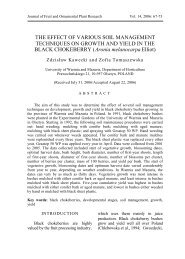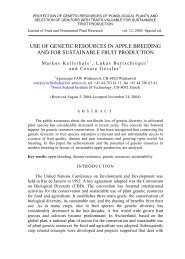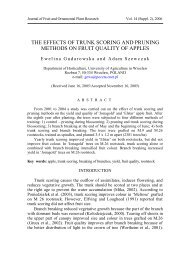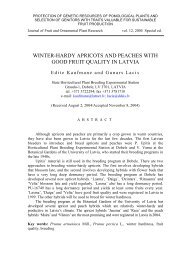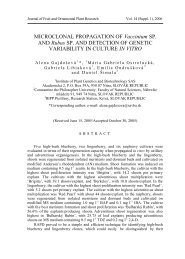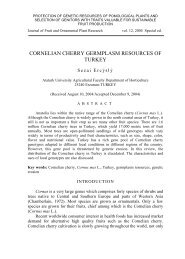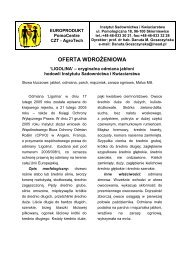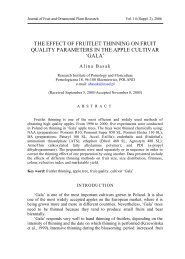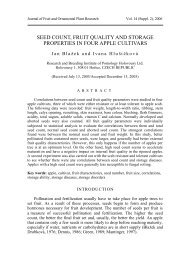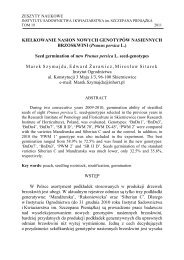productivity and fruit quality of scab resistant apple cultivars and ...
productivity and fruit quality of scab resistant apple cultivars and ...
productivity and fruit quality of scab resistant apple cultivars and ...
- No tags were found...
You also want an ePaper? Increase the reach of your titles
YUMPU automatically turns print PDFs into web optimized ePapers that Google loves.
Journal <strong>of</strong> Fruit <strong>and</strong> Ornamental Plant Research Vol. 14 (Suppl. 2), 2006PRODUCTIVITY AND FRUIT QUALITY OF SCABRESISTANT APPLE CULTIVARS AND HYBRIDSA u d r i u s S a s n a u s k a s * , D a l i a G e l v o n a u s k i e n ė,B r o n i s l o v a s G e l v o n a u s k i s , P r a n a s V i s k e l i s ,P a v e l a s D u c h o v s k i s , C e s l o v a s B o b i n a s ,J u r a t e S i k s n i a n i e n ėa n d G i n t a r e S a b a j e v i e n ėLithuanian Institute <strong>of</strong> Horticulture, Kauno 30, BabtaiKaunas district, LT-54333, LITHUANIA*Corresponding author: e-mail: A.Sasnauskas@lsdi.it(Received June 16, 2005/Accepted November 7, 2005)A B S T R A C TFrom 1997 to 2004, six new <strong>apple</strong> hybrids <strong>and</strong> three st<strong>and</strong>ard <strong>cultivars</strong> grafted onM26 rootstock were evaluated at the Lithuanian Institute <strong>of</strong> Horticulture. Datarecorded included frost damage, blossoming time, harvest time, storability,chlorophyll content, carotenoids content, <strong>fruit</strong> <strong>quality</strong> parameters, <strong>and</strong> biochemicalcomposition. Of the new varieties, ‘Skaistis’ <strong>and</strong> ‘Rudenis’ had the best overallresults. The following <strong>apple</strong> genotypes were selected for breeding <strong>of</strong> certaincharacteristics: blossoming time: ‘Skaistis’, 18429 <strong>and</strong> 18501; flower resistance t<strong>of</strong>rost: ‘Prima’ <strong>and</strong> 18437; winter hardiness: 18422; leaf chlorophyll content: ‘Staris’<strong>and</strong> 18437; yield: ‘Rudenis’, 18429 <strong>and</strong> ‘Skaistis’; storability: ‘Tellissaare’, ‘Staris’<strong>and</strong> ‘Skaistis’; <strong>fruit</strong> weight: ‘Skaistis’ <strong>and</strong> 18501; <strong>fruit</strong> <strong>quality</strong>: 18429, 18437,‘Rudenis’ <strong>and</strong> ‘Skaistis’; biochemical composition: ‘Tellissaare’ <strong>and</strong> 18422.Key words: <strong>apple</strong>, <strong>productivity</strong>, <strong>quality</strong> <strong>of</strong> <strong>fruit</strong>s, <strong>cultivars</strong>, hybridsINTRODUCTIONNew <strong>apple</strong> <strong>cultivars</strong> should have the following traits: excellent <strong>fruit</strong><strong>quality</strong>, reliably high yield, excellent taste, storability, marketability <strong>and</strong>disease resistance, especially to <strong>apple</strong> <strong>scab</strong> (Venturia inaequalis), powderymildew (Podosphaera leucotricha) <strong>and</strong> fire blight (Erwinia amylovora)(Fischer, 2000; Blazek, 2001; Kelderer <strong>and</strong> Lardschneider, 2004; Kemp et al.,2004; Werth, 2004).The <strong>apple</strong> breeding program has been in existence at the LithuanianInstitute <strong>of</strong> Horticulture since 1952. Several commercially grown <strong>cultivars</strong>
A. Sasnauskas et al.have been released, including ‘Auksis’, ‘Noris’, ‘Staris’ <strong>and</strong> ‘Aldas’. Themost successful <strong>of</strong> these is ‘Auksis’, which has become the most importantcultivar in Lithuania. The primary goals <strong>of</strong> our breeding work have been <strong>fruit</strong><strong>quality</strong>, yield <strong>and</strong> resistance to <strong>apple</strong> <strong>scab</strong>. Scab <strong>resistant</strong> <strong>cultivars</strong> allowgrowers to save on disease control costs, decrease environmentalcontamination associated with fungicide use, <strong>and</strong> meet consumer dem<strong>and</strong>s for<strong>apple</strong>s with lower amounts <strong>of</strong> pesticide residue (Kühn <strong>and</strong> Thybo, 2001).There is currently widespread resistance to using <strong>scab</strong> <strong>resistant</strong> <strong>cultivars</strong> inorganic <strong>apple</strong> production, even though they have great ecological <strong>and</strong>economic advantages. Apple growers undermine their credibility by plantingtrendy <strong>scab</strong> susceptible <strong>cultivars</strong> (Weibel <strong>and</strong> Leder, 2003).The objective <strong>of</strong> this study was to evaluate yield <strong>and</strong> <strong>fruit</strong> <strong>quality</strong> in new<strong>scab</strong> <strong>resistant</strong> <strong>apple</strong> <strong>cultivars</strong> <strong>and</strong> hybrids.MATERIAL AND METHODSFrom 1997 to 2004, six new <strong>apple</strong> hybrids <strong>and</strong> three st<strong>and</strong>ard <strong>cultivars</strong>were evaluated at the Lithuanian Institute <strong>of</strong> Horticulture.Temperature is the most important factor determining yield in <strong>apple</strong>s,especially minimal winter <strong>and</strong> spring temperatures. Late spring frosts in 1999,2000 <strong>and</strong> 2004 did a lot <strong>of</strong> damage to the developing blossoms. At thesetimes, the minimal air temperature above the ground dropped to -5 o C in theorchard.The following <strong>scab</strong> resistance hybrids were evaluated: ‘Skaistis’ (18307),‘Rudenis’ (18451), 18422, 18429, 18437 <strong>and</strong> 18501 (Katja x Prima). All weredeveloped at the Lithuanian Institute <strong>of</strong> Horticulture. They were compared tothe st<strong>and</strong>ard <strong>cultivars</strong> ‘Tellissaare’, ‘Prima’ <strong>and</strong> ‘Staris’.In the spring <strong>of</strong> 1997, trees were planted 4 x 2.5 m in twelve replicates <strong>of</strong>one tree each. Trees were trained as spindles. All trees were maintained inaccordance with st<strong>and</strong>ard procedures recommended for commercial orchards.Trees <strong>and</strong> <strong>fruit</strong>s were evaluated in accordance with UPOV Test Guidelines(2005). Carotenoids <strong>and</strong> chlorophylls were recorded in mg/m 2 . Appearance,taste <strong>and</strong> <strong>quality</strong> were evaluated on a scale from 1 to 9.Data were elaborated by analysis <strong>of</strong> variance, followed by Fisher’sprotected LSD <strong>and</strong> Duncan’s multiple-range t-test at P=0.05.Blossoming <strong>of</strong> <strong>apple</strong> treesRESULTSApple trees <strong>of</strong> most varieties started blossoming in their second year inorchard. Blossoming was earliest in ‘Tellissaare’ <strong>and</strong> ‘Rudenis’ (May 5), <strong>and</strong>latest in ‘Staris’ (May 9). Full blossoming began earliest in ‘Rudenis’ (May8), <strong>and</strong> latest in Hybrid 18429 (May 17). Full blossoming ended earliest in‘Tellissaare’ <strong>and</strong> Hybrid 18437 (May 16), <strong>and</strong> latest in Hybrid 18429, Hybrid18501 <strong>and</strong> ‘Skaistis’ (May 19).248J. Fruit Ornam. Plant Res. vol. 14 (Suppl. 2), 2006: 247-255
Productivity <strong>and</strong> <strong>fruit</strong> <strong>quality</strong> <strong>of</strong> <strong>scab</strong> <strong>resistant</strong> <strong>apple</strong>…Blossoming <strong>and</strong> cold injury on shootsDuring the evaluation period, severe spring frosts occurred in three years:1999, 2000 <strong>and</strong> 2004. In 1999, blossoms on most varieties were moderatelydamaged, with damage scores between 2.2 <strong>and</strong> 3.2. In 2000, the damage wasvery severe, with damage scores between 7.0 <strong>and</strong> 7.6. In 2004, damage wasagain moderate, with an average damage score <strong>of</strong> 3.9.The varieties with the highest level <strong>of</strong> resistance to flower damage by frostwere ‘Prima’ <strong>and</strong> Hybrid 18437.In 2003-2004, slight frost damage was observed on shoots <strong>of</strong> ‘Prima’,with a damage score <strong>of</strong> 2.0.In 2004-2005 annual shoots <strong>of</strong> some varieties were slightly damaged, forexample ‘Prima’ had a damage score <strong>of</strong> 1.9, <strong>and</strong> Hybrid 18429 had a damagescore <strong>of</strong> 1.8. Shoots <strong>of</strong> Hybrid 18422 were not damaged.ChlorophyllLeaf chlorophyll levels were highest during intense <strong>fruit</strong> growth in all <strong>of</strong>the varieties evaluated. Leaf chlorophyll levels were highest in ‘Staris’ <strong>and</strong>Hybrid 18437, <strong>and</strong> lowest in ‘Tellissaare’ <strong>and</strong> Hybrid 18501 (Fig. 1).700,002003 2004600,00500,00mg/m 2400,00300,00200,00100,000,001 2 3 4 5 6 7 8 91 – ’Tellissaare’; 2 – ‘Staris’; 3 – ‘Prima’; 4 – ‘Skaistis’; 5 – 18422; 6 – 18429;7 – 18437; 8 –‘Rudenis’; 9 – 18501Figure 1. Total amount <strong>of</strong> chlorophylls [mg/m 2 ] in <strong>apple</strong> leavesJ. Fruit Ornam. Plant Res. vol. 14 (Suppl. 2), 2006: 247-255 249
A. Sasnauskas et al.CarotenoidsCarotenoids take active part in photosynthesis. The level <strong>of</strong> carotenoidschanges during the vegetative growth <strong>and</strong> in response to stress. The level <strong>of</strong>carotenoids was highest in ‘Staris’ <strong>and</strong> Hybrid 18437, <strong>and</strong> lowest in‘Tellissaare’ <strong>and</strong> Hybrid 18501 (Fig. 2).mg/m 2180,00160,00140,00120,00100,0080,0060,0040,0020,000,002003 20041 2 3 4 5 6 7 8 91 – ’Tellissaare’; 2 – ‘Staris’; 3 – ‘Prima’; 4 – ‘Skaistis’; 5 – 18422; 6 – 18429;7 – 18437; 8 – ‘Rudenis’; 9 – 18501Figure 2. The amount <strong>of</strong> carotenoids [mg/m 2 ] in <strong>apple</strong> leavesYieldIn the third year in the orchard, yield was highest in ‘Tellissaare’ (4.8t/ha), while ‘Prima’ <strong>and</strong> Hybrid 18501 did not bear <strong>fruit</strong> at all (Fig. 3).In the fourth year, yield were low in all varieties because <strong>of</strong> the severespring frost damage (0.4 to 1.5 t/ha).In the fifth <strong>and</strong> seventh years, yields were higher.In the sixth year, yields were highest in ‘Rudenis’ (115.3 t/ha), Hybrid18429 (99.6 t/ha) <strong>and</strong> ‘Skaistis’ (87.5 t/ha), <strong>and</strong> lowest in Hybrid 18422 (48.8t/ha), ‘Staris’ (46 t/ha), <strong>and</strong> Hybrid 18501 (34.4 t/ha).250J. Fruit Ornam. Plant Res. vol. 14 (Suppl. 2), 2006: 247-255
A. Sasnauskas et al.Quality parametersFruit appearance was good (7.0 to 7.5) or extremely good (> 7.5) in allvarieties. Fruit appearance was best in Hybrid 18437 (7.7), ‘Skaistis’ (7.6) <strong>and</strong>‘Rudenis’ (7.6) (Tab. 1).Taste was extremely good in Hybrid 18429 (7.6) <strong>and</strong> ‘Skaistis’ (7.4),moderately good in ‘Staris’ (5.9) <strong>and</strong> Hybrid 18422 (5.7), <strong>and</strong> good in all theother varieties.Organoleptic <strong>quality</strong>, which is a general estimate <strong>of</strong> both appearance <strong>and</strong>taste, was very good in Hybrid 18429 (7.6), Hybrid 18437 (7.5), ‘Rudenis’(7.5) <strong>and</strong> ‘Skaistis’ (7.5), <strong>and</strong> good in all the other varieties except Hybrid18422 (5.8).Fruit size was large in all varieties (120-128 g), except in ‘Tellissaare’ <strong>and</strong>Hybrid 18429, which had average sized <strong>fruit</strong>s. The proportion <strong>of</strong> <strong>fruit</strong>s over70 mm in diameter was highest in ‘Skaistis’ <strong>and</strong> ‘Staris’ (28 to 31%). Theproportion <strong>of</strong> <strong>fruit</strong>s <strong>of</strong> the smallest size class was highest in Hybrid 18422 <strong>and</strong>Hybrid 18501 produced the highest amount <strong>of</strong> smallest <strong>fruit</strong>s (Fig. 4).Percent60504030201001 2 3 4 5 6 7 8 975 mm <strong>and</strong> over75 mm70 mm65 mm60 mm55 mmCultivars <strong>and</strong> hybrids1 – ‘Tellissaare’; 2 – ‘Staris’; 3 – ‘Prima’; 4 – ‘Skaistis’; 5 – ‘Rudenis’; 6 – 18422;7 – 18429; 8 – 18437; 9 – 18501Figure 4. Classification <strong>of</strong> <strong>apple</strong> <strong>cultivars</strong> <strong>and</strong> hybrids according to <strong>fruit</strong> diameter [%](Babtai, 2002-2004)Chemical compositionSoluble solids content was highest in ‘Tellissaare’ (13.6%), <strong>and</strong> lowest inHybrid 18437 (10.8%) (Tab. 2). Titratable acidity ranged from 0.31 to 0.72%.Dry matter content in <strong>apple</strong>s ranged from 12.1% in Hybrid 18437 to 15.2% in‘Tellissaare’. Skin firmness was highest in ‘Tellissaare’ <strong>and</strong> ‘Staris’. Fleshfirmness was highest in ‘Tellissaare’ <strong>and</strong> Hybrid 18422.252J. Fruit Ornam. Plant Res. vol. 14 (Suppl. 2), 2006: 247-255
Productivity <strong>and</strong> <strong>fruit</strong> <strong>quality</strong> <strong>of</strong> <strong>scab</strong> <strong>resistant</strong> <strong>apple</strong>…T a b l e 2 . Chemical <strong>and</strong> physical characteristics <strong>of</strong> <strong>apple</strong> <strong>cultivars</strong> <strong>and</strong> hybrids,2003-2004Cultivars<strong>and</strong> hybridsSolublesolids[%]Titratableacidity[%]Dry matter[%]Firmness <strong>of</strong>skin[kg/cm 2 ]Firmness <strong>of</strong>flesh[kg/cm 2 ]‘Tellissaare’ 13.6 h * 0.52 d 15.2 h 38.1 i 6.0 d‘Staris’ 11.6 b 0.31 a 13.2 b 33.2 h 4.1 a‘Prima’ 12.1 c 0.43 b 13.6 d 28.3 g 5.1 g‘Skaistis’ 12.3 d 0.53 d 13.3 c 23.8 b 5.3 b‘Rudenis’ 11.6 b 0.60 g 13.5 b 24.6 c 4.5 e18422 13.4 g 0.48 c 14.6 g 24.8 d 6.0 d18429 13.1 f 0.72 h 13.8 e 26.2 e 4.6 f18437 10.8 a 0.58 f 12.1 a 22.3 a 5.3 b18501 12.9 e 0.57 e 14.3 f 26.4 f 5.4 h*Means followed by the same letter do not differ significantly at P = 0.05 according to Duncan’s t-testDISCUSSIONBlossoming time depends on several factors, including spring weather,exposure, soil, moisture <strong>and</strong> rootstock. The differences in blossoming timefrom year to year were caused by weather differences, particularly differencesin temperature. Weather differences also affected pollination. Late blossomingis a desirable trait because it minimizes damage by late spring frosts (Blazek,2001). The earliest blossoming varieties were ‘Tellissaare’ <strong>and</strong> ‘Rudenis’, <strong>and</strong>the latest blossoming varieties were Hybrids 18429, Hybrid 18501 <strong>and</strong>‘Skaistis’. In ‘Staris’, blossoming was more intense in our study than in aprevious study, in which blossoming was weaker, even in the fourth year in theorchard (Rašinskienė<strong>and</strong> Žika, 1997).Both chlorophylls <strong>and</strong> carotenoids were highest in ‘Staris’ <strong>and</strong> Hybrid18437. Our data show that different genotypes might have different strategiesfor <strong>productivity</strong>.Eight-year cumulative yield was highest in ‘Rudenis’, ‘Skaistis’ <strong>and</strong> Hybrid18429, <strong>and</strong> lowest in ‘Staris’, Hybrid 18422 <strong>and</strong> Hybrid 18501. ‘Staris’ on M26rootstock was late cropping <strong>and</strong> low yielding in the maiden age (Rašinskienė<strong>and</strong>Žika, 1997).Storability is the most important criterion when selecting <strong>cultivars</strong> for acommercial orchard. Storability was best in ‘Tellissaare’, ‘Staris’ <strong>and</strong>‘Skaistis’.Fruit <strong>quality</strong> parameters reflect desirable sensory properties such us color,size, shape, flavour, firmness, juiciness <strong>and</strong> texture. Fruit <strong>quality</strong> in <strong>apple</strong>s isdifficult to measure because <strong>of</strong> its subjective nature (Blazek <strong>and</strong> Hlusickova,2003). Consumer preferences for <strong>apple</strong>s are generally based on the interactionbetween texture <strong>and</strong> taste. All <strong>fruit</strong> <strong>quality</strong> parameters depended on the varietyJ. Fruit Ornam. Plant Res. vol. 14 (Suppl. 2), 2006: 247-255 253
Productivity <strong>and</strong> <strong>fruit</strong> <strong>quality</strong> <strong>of</strong> <strong>scab</strong> <strong>resistant</strong> <strong>apple</strong>…PLENNOŚĆI JAKOŚĆOWOCÓW JABŁONI ODMIANI HYBRYD PARCHOODPORNYCHA u d r i u s S a s n a u s k a s , D a l i a G e l v o n a u s k i e n ė,B r o n i s l o v a s G e l v o n a u s k i s , P r a n a s V i s k e l i s ,P a v e l a s D u c h o v s k i s , C e s l o v a s B o b i n a s ,J u r a t e S i k s n i a n i e n ėi G i n t a r e S a b a j e v i e n ėS T R E S Z C Z E N I EW latach 1997-2004 w Litewskim Instytucie Ogrodnictwa badano 6 nowychhybryd i 3 st<strong>and</strong>ardowe odmiany jabłoni zaszczepione na podkładce M.26. Ocenianouszkodzenia mrozowe, termin kwitnienia, termin zbioru, trwałośćprzechowalniczą,zawartośćchlor<strong>of</strong>ilu, zawartośćkarotenoidów, parametry jakości owoców i składbiochemiczny owoców.Nowe odmiany ‘Skaistis’ i ‘Rudenis’ uzyskały najwyższe oceny pod względemwszystkich ocenianych cech. Do dalszej hodowli wybrano następujące genotypyjabłoni ze względu na ich ustalone cechy: czas kwitnienia – ‘Skaistis’, 18429 i 18501;odpornośćkwiatów na mróz – ‘Prima’ i 18437; zimoodporność– 18422; wyższązawartośćbarwników fotosyntetycznych w liściach – ‘Staris’ i 18437; plenność–‘Rudenis’, 18429 i ‘Skaistis’; trwałośćprzechowalniczą– ‘Tellissaare’, ‘Staris’i ‘Skaistis’; masęowoców – ‘Skaistis’ i 18501; jakośćowoców – 18429, 18437,‘Rudenis’ i ‘Skaistis’, najlepszy skład biochemiczny – ‘Tellissaare’ i 18422.Słowa kluczowe: jabłoń, plenność, jakośćowoców, odmiany, hybrydyJ. Fruit Ornam. Plant Res. vol. 14 (Suppl. 2), 2006: 247-255 255




